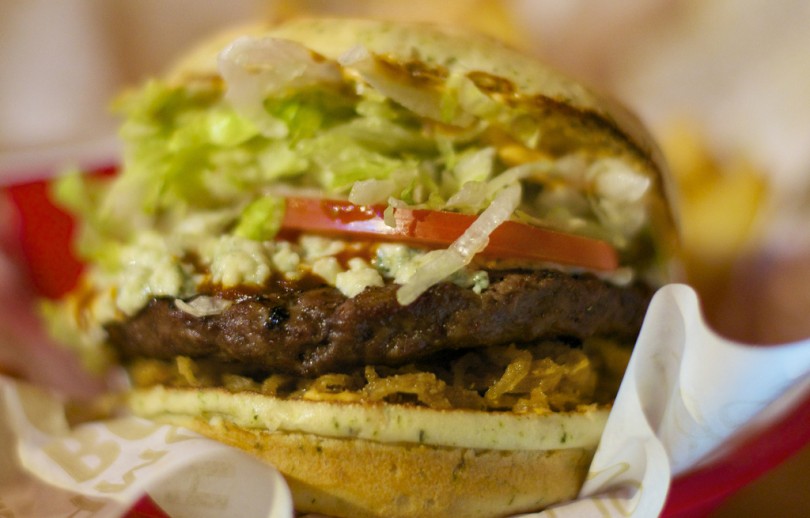aNewDomain — How about some large earthworm jerky? How about Puffin heart? Some Rocky Mountain oysters? You can order any of these strange foods online these days. But would you believe you can get a lab-grown burger — all muscle — that was entirely grown in a test tube? Stem cell burgers will be commercially viable within a decade or two, but some lucky souls got to sample this new edible (ahem) treat (cough!) in London a while back. And they liked it.
Here are some fun facts about the world’s first stem cell burger.
The burger was made in a petri dish. I’ll take mine medium, please.
To make the burger, the scientists in the lab of Dr. Mark Post at the University of Masstricht (Netherlands) cultured stem cells they harvested from a cut of cow shoulder meat.
 The stem cells — these are flexible, building block cells that have the potential to grow into different cell types — were nudged to grow into muscle cells. They were placed in a petri dish, doused in a nutrient-rich solution and then grown into super thin strips of muscle tissue.
The stem cells — these are flexible, building block cells that have the potential to grow into different cell types — were nudged to grow into muscle cells. They were placed in a petri dish, doused in a nutrient-rich solution and then grown into super thin strips of muscle tissue.
The scientists combined about 20,000 of these thin meat tissues to create a five ounce mass, then red beet juice and saffron were added for color.
Regular meat, in case you didn’t know, is muscle. So the main thing that has changed here is that the stem cell meat was lab-grown without the typical mix of uric acid and fat that usually seeps in.
Lab-grown meat tastes like meat. Kind of.
That’s why the stem cell burger tasted close to, but not exactly like, meat. The stem cell burger has no fat at all. And even though English chef Richard McGeown flavored the muscular vitro patty with breadcrumbs, salt and copious amounts of butter, the final product still felt like something essential was missing from the lean patty. Something unctuous.
As Chicago-based food writer Josh Schonwald told NBC News:
There is a leanness to it. The absence of fat is what makes it taste different … I would say it is somewhere on the spectrum between a Boca Burger [soy burger brand] and McDonald’s. The absence of fat makes a big difference. It has the texture, which I was not expecting. It was like an animal-protein cake.”
 If you’d try a stem cell burger, you’re braver than most.
If you’d try a stem cell burger, you’re braver than most.
Of course, not everyone is thrilled by the prospect of eating meat grown in a petri dish. And descriptors like “animal protein cake” won’t exactly get prospective customers elbowing each other out of the way for a taste.
According to a 2014 Pew Research Center survey, 80 percent of Americans would be unwilling to try meat grown in a laboratory. The survey also found that younger, college-educated people would be more willing to give it a go.
Indeed, the five-ounce “Frankenburger” is certainly divisive. Others warn against the understudied health risks that may result from consuming experimental meat not yet approved for human consumption.
Not that the current state of low-grade industrial cow meat is superior, by any means. I wonder how many of those polled would unwittingly — or uncaringly — eat the infamous pink slime that pervades modern fast food meat.
Hamburger chef and food activist Jamie Oliver famously broke down the “pink slime process:” scraps of tendon and meat bits that were previously considered inedible are inserted into a centrifuge, to separate the chewy bits from the bony bits. The resulting meat product is then disinfected with ammonia. Tasty.
But it’s an environmentally friendly burger. Would you try it now?
The detrimental impact of the meat industry on the environment is well known: The meat industry contributes about 18 percent of global greenhouse gas emissions, according to a 2006 environmental report by The Livestock, Environment, and Development (LEAD) initiative.
And it’s only growing.
The Dutch scientist says that his aim was to reduce the environmental impact of the future of meat consumption. “Current meat production is at its maximum — we need to come up with an alternative,” Dr. Post told Reuters.
Lab-grown meat will likely hit shelves in 10 to 20 years. You’ll get used to it. Promise.
The future of food may arrive sooner than you think. Dr. Post is optimistic about the commercial viability of cultured meat. He estimates that it will take at least 10 years before it hits stores.
The estimated price of cultured meat is $30 a pound, but this exorbitant cost could be reduced through a larger scale production. Kind of like the human-baby-as-a-battery-power-source scene in the Matrix, but less dramatic, and perhaps less dystopian.
For aNewDomain, I’m Raquel Cool.
Ed: The original version of this article ran on aNewDomain’s BreakingModern. Read it here.
Images in order: Blue Cheese Burger by Edward Sargent via Flickr; Hamburger by Jeffrey Bary via Flickr; My New Porkert #5 Meat Grinder by Robin via Flickr













